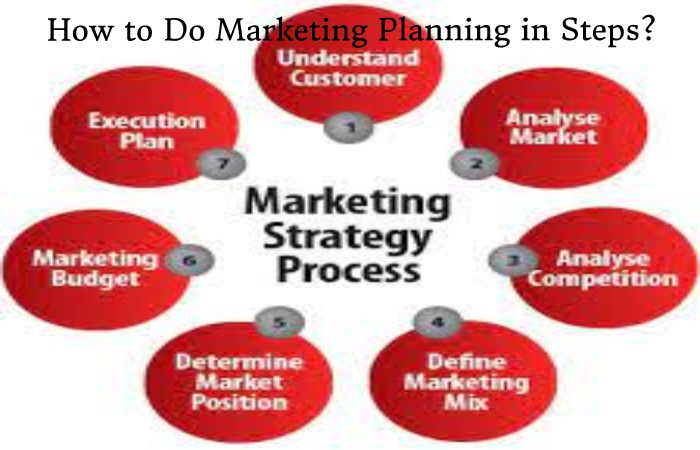Marketing Plan Definition
A marketing planning is an organized and structured document in which the commercial objectives to remain achieved in a given period are defined. The paper details the strategies and actions that will remain undertaken to achieve the goals in the foreseen term. It is integrated and is part of the strategic plan of a company.
How to Do Marketing Planning in Steps?

Step 1: Analysis Of The Situation (External And Internal)
The starting point is usually always an analysis of the current situation. The idea is that we have an analysis of the external and internal aspects of a company.
The external aspects include the competition, the primary market of interest, the current clients, and the buyer. The ideal client profiles (buyer personas) will be used later in many moments within the marketing plan and the definition of tactics and implementation.
Meanwhile, the internal aspects involve its structure, economic and human resources, objectives, etc.
It is, therefore, about determining where we are, what the scenario is, the history, and the objectives of the business.
To carry out this analysis, it is essential to prepare a SWOT, a study that helps us discover:
The strengths and weaknesses that we have internally, related to our organization, product, or services.
The opportunities or threats that we have externally.
When analyzing opportunities and threats, we must bear in mind that these variables affect our competition since they are market elements.
SWOT analysis is fundamental because it allows us to define the necessary strategies to take advantage of and maximize opportunities and minimize or eliminate threats.
Step 2: Defining Objectives
Once the analysis of the initial situation has remained carried out, we must define the objectives. IT is a significant step for our marketing strategy to be successful. It will depend on this definition to establish the strategy, tactics, and measurement elements that justify the remaining investment.
To correctly define objectives that help the success of our marketing planning, they must be smart. The SMART goals are:
Specific: They must be concrete, without abstractions. For example, increase sales through an internet marketing action.
Measurable: They must be quantifiable so that we can measure their scope. If the objectives are not measurable, they will be purposes and wishes, but not strategic objectives. Following the previous example, we would say “increase sales by 25% through an internet marketing planning action”.
Achievable: They must be possible, practicable and, for this, it is essential to take as a basis the results of the SWOT. For example, if we are a recently created SME, we cannot set a goal to lead the market for real estate sales on the internet in just half a year.
Relevantes (Relevant): They must be appropriate to our business. In line with the previous point (achievable), we cannot set objectives outside of the general purposes of our business.
Limited in time (Targeted and Time-Bound): We must establish the time in which the objective must remain reached. Following the first example, we would say, “increase sales by 25% through internet marketing planning within the next 12 months”.
Some examples of SMART goals are:
- I am billing 200,000 euros by 2020, adding digital marketing channels and internet sales.
- Position the brand in social networks through ads and campaigns in 6 months.
- Increase the organic visits of the website by 15% per month for one year, doubling the production and distribution of content.
Step 3: Defining Strategies
At this point, we must set our strategy based on our objectives, which can also remain used to correct and enhance the data that we have extracted with our SWOT analysis.
Starting from our initial SWOT, we can elaborate a cross SWOT that will help us establish strategies, starting with offensive ones, continuing with adaptive and survival ones, and ending with defensive ones.
FO strategies: taking advantage of opportunities and relying on strengths, we define our offensive strategy.
DO strategies: faced with the inability to take advantage of an opportunity due to weakness, we establish our adaptive strategy.
DA strategies: are based on the existence of a threat that allows us to lean on a weakness; this is how we establish survival and conservation strategies.
FA strategies: before the possibility of leaning on a fortress to reduce the likelihood of a threat, we establish the defensive strategy.
Step 4: Defining Tactics And Actions
Based on the established strategies, we must develop the tactics that we will carry out and, within these, the list of actions to be carried out to achieve the objectives.
There are different tactics that we can carry out, for example:
- RACE method: Reach (reach the audience); Act (influence the audience to make decisions); Convert (my potential clients buy); Engage (get retain and loyalty).
- Inbound marketing.
- Email marketing.
- Content Marketing.
- Search Engine Marketing ( SEM ).
- And also search Engine Optimization (SEO).
- Within each tactic, we must establish a specific list of actions that we can later set on our calendar to confirm the order and time of their implementation.
Step 5: Scheduling Of Actions
As discussed in the previous point, once the tactics and actions are defined, it is essential to make decisions and list the calendar. Correctly placing each of the activities in order and at the moment will help us to meet our objectives.
Step 6: Budget
Once the calendar has been established, which includes the actions linked to the tactics and strategies that will allow us to achieve our objectives, we must prepare the budget that demonstrates the human and financial resources necessary to comply with our marketing strategy.
Step 7: Control System
The control system is the last step in the development of our marketing plan. As we have commented in the definition of objectives, these must be measurable to control their fulfillment.
Keeping this control during the implementation of our plan will allow us to detect possible failures and deviations and react in time to apply corrective measures that ensure the achievement of the objectives and the maximization of the ROI. Therefore, we must establish control mechanisms for each objective and in partial realizations, not only for its scope at the end of the process.
To integrate these concepts and automate your system, consider implementing a balanced scorecard dashboard that integrates your KPIS with your scorecard, strategy maps, and reports so you can see how well you’re executing your overall strategy.
Control Panel of Marketing Planning

The scorecard will summarize each of the objectives, ordered by importance (represented by a percentage of quota). A suitable technique to visually show the scope of each purpose during the process is the traffic light technique. In it, for each objective, it is established:
- The correct range as forecast (green)
- A slight deviation (yellow)
- A total departure from the estimates (red)
- Example of scorecard by objective:
- And also, key Performance Indicators (KPIs)
KPIs are metrics that assist us in identifying the scope of our strategy and remain based on the objectives we have set. They can be qualitative or quantitative. To ensure that the measurement is optimal, it is recommended not to include more than 10 KPIs in our plan. Otherwise, the measure would be complex and not very fruitful.
Some Examples Of KPIs:
- Impacts (direct and indirect mentions on social networks).
- Levels (competition ratios, lists, followers, followings);
- Conversions (RTs, RTs ratio, web traffic, sales).
- I was feeling (positive, negative, indifferent, resolved).
- Levels (type of influence, speed, forgiveness, or criticism).
- Conversions (harmful to good, wrong to neutral).
- Derivatives (influence of our followers).
- And also, Return On Investment (Roi)
The ROI compares the benefit concerning the investment made. It is a ratio, and it is not studied alone, but it remains reached. The higher it is, the better. In marketing, return on investment allows you to analyze the performance of a campaign or strategy from a financial point of view.
The formula to calculate it is as follows: ROI = (Return on investment – Cost of investment) / Cost of investment.
Related searches to Marketing Planning
[7 steps of e marketing plan]
[steps in preparing marketing plan ppt]
[7 steps of marketing strategy process]
[e-marketing plan 7 steps pdf]
[how to create a marketing plan template]
[developing marketing strategies and plans pdf]
[marketing plan steps pdf]
[what are the ideal marketing plan implementation steps]
Also Read: Realtime Cryptocurrency Prices: Latest Crypto Prices


